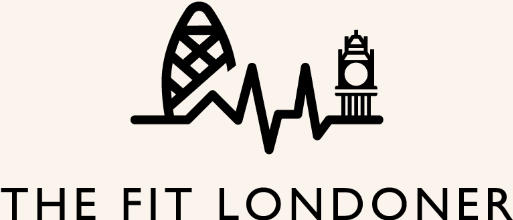

To round off a year of big challenges, including my first triathlon and Ironman UK, I ticked ‘completing a multi-stage ultra marathon’ off my bucket list by taking part in the Wadi Rum Ultra marathon 2018. Set in the Wadi Rum desert in Jordan, the multistage desert race covers running just over 250km in five days. So what was it like?
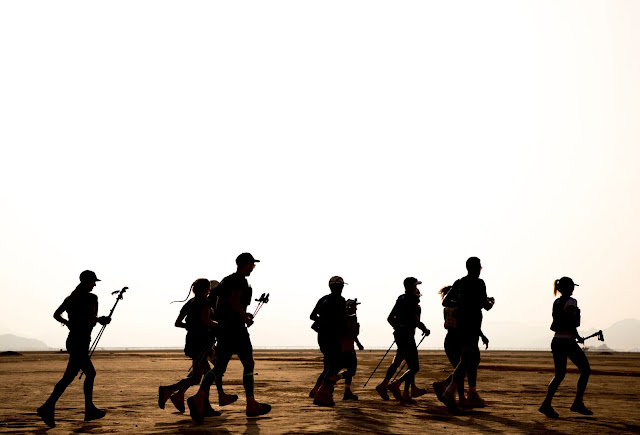
Arriving at the airport on a Saturday afternoon, as soon as I reached the check-in desk, it was obvious who was taking part in Wadi Rum Ultra. Among the Jordanian nationals and tourists queuing up to check in luggage, were lycra-clad individuals with large hiking backpacks. People had travelled from Bolton, Cornwall and Yorkshire for this ultra. I was taking part in the event with Team Like A Girl, who aims to show normal women taking on extraordinary challenges.

When we arrived at Jordan, Sam and Jamie, the organisers of Wadi Rum ultra, met us along with some of the volunteers who would be crewing the event over the week. After we had been given our visas, we headed to a hotel in Amman for rest of the night. The next morning, Sunday, started with a race briefing followed by our mandatory kits checked to ensure we had everything required. I had found it interesting when packing my bag that a large portion of my bag’s weight came from the food I had packed.
The race organisers had given us a maximum weight limit of 14 kg for our luggage, which no-one seemed to have stuck to: my bag weighed 17 kg and many of the others’ bags weighed just under 20 kg. Luckily, there was no penalty for this (our bags weren’t weighed by the race organisers). I guess the aim of this bag weight restriction was to ensure we wouldn’t go to town with items we put in our bags for the ultra and just pack sensibly. And, if anything, what I found throughout Wadi Rum Ultra was I had overpacked on food, but more on that later.
From Amman, our coach drove us to the Wadi Rum desert. By the time we arrived that evening, it was just starting to get dark. There we transferred to open backed trucks, each holding about six people. That was the start of the adventure: the truck I was in got a deflated tyre twice during the drive to our camp, which we found quite funny.
The first night in the desert was quite exciting: from eating my first dehydrated meal of the trip to unpacking and making sure everything was prepped and ready for the next day. Sleeping arrangements were in the form of a bivouac village, with bivouacs holding about 4-8 people each. There was around 40 people taking part in the ultra, giving it a small and friendly feeling.
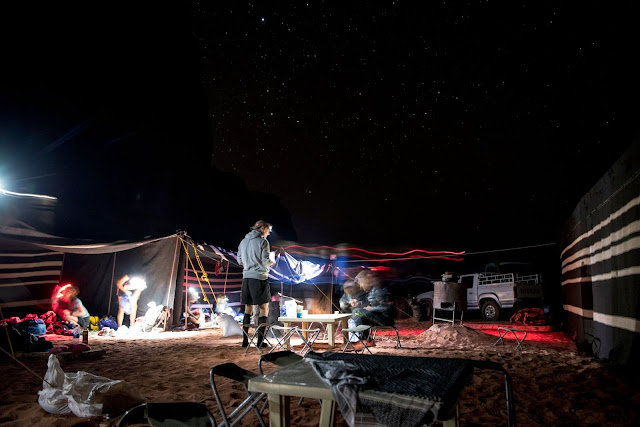

Whilst the majority were from UK, others were from across the world including Jordan, Germany, Switzerland and Japan. Salameh Al Aqra, a Jordanian elite runner who has won Marathon des Sables, was also at the ultra – he was using the week for training.
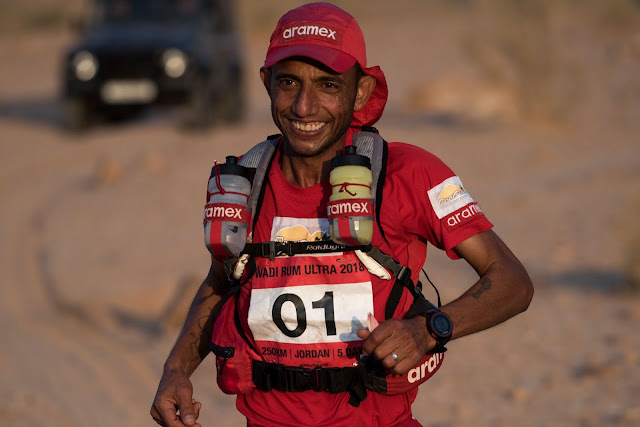
Two things I really liked about the Wadi Rum ultra was the gender balance and average of the participants: of the ultras I’ve seen, they’re often mostly white middle-aged men, which can put off people from taking part. At Wadi Rum, there was a good mix of ages. The average age was much, much younger than other ultras- a large number of us were under 30, and there was a good mix of women and men which was so refreshing to see.

The morning of day one of the ultra was also the the first time we really got to see the campsite and see the desert in all its glory. The dramatically shaped rocks draped the landscape, featuring deep red valleys of sandstone jebels. Just as we murmured to each other that it looked like film set of somewhere like The Martian, we found out this was where film had been filmed. Not sure what it must have been like for the actors, all dressed in astronaut gear and walking around in soaring heat……

Daily camp life routines started to emerge in the morning. We would wake up, get dressed, tape up our feet for blister prevention, check our bags were packed for the day then pop over to the communal areas where there would be fires where water would be heated for our dehydrated breakfasts. The great thing about Wadi Rum ultra is that while we have to pack everything, including nutrition for the whole week, in our main luggage, this was kept at the campsite and transported from camp to camp throughout the week. This meant that each day we would only need to carry the necessary nutrition, drinks and medical kit for that day with us. If you’re looking to take on your first multi-stage ultra, this is a factor I’d definitely recommend looking into. Having only to take the nutrition and drinks we needed each day reduced any stress and added to the enjoyment of the experience. There were many people at Wadi Rum who had done other multi stages and they all agreed that this was a positive. To add to this, we discovered that the camp for the first three nights had toilets, a luxury that we hadn’t expected. If you’re entering your first multi-stage event, having a bathroom at base camp may be something you want to factor in. When the race was nearly ready to start, Jamie and Sam would call us out to get to the start line. The moment we started walking on the soft, reddish sand around the start line and seeing it go on and on was when it really hit me about we were going to do for the next five days. Unlike other events where the course is mapped out in advance, we never knew what the course would look like in advance. Each evening, Sam and Jamie would tell the local Bedouins the distance we needed to cover the next day, and the Bedouins would work their magic and create a route for us that evening. I found this so incredible. To me and the rest of the runners, the jebels looked the same, but for the local Bedouins, the jebels and the Wadi Rum desert was as familiar to them as London streets are to me. They would go out in the early hours of the morning each day to mark out the course with pink flags.

Besides day five, day one was the latest we would wake up during the five days in the desert: as the distances got longer, we had earlier race starts to ensure everyone would be able to get back to camp before sunset.
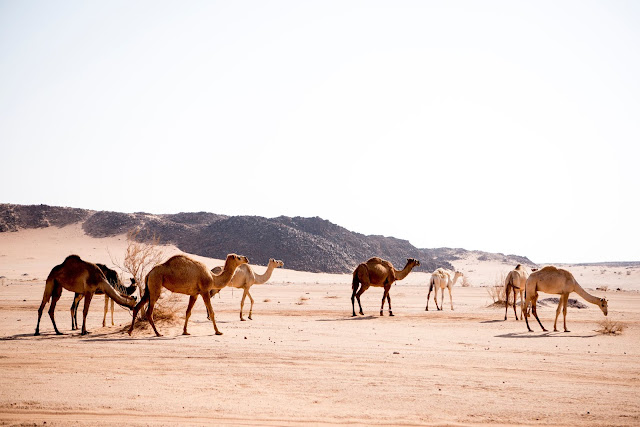
Throughout the week, the distances broke up as such: Day one: 45 km Day two: 53 km
Day three: 70 km
Day four: 50 km Day five: 37 km
Sam, who had taken part in the Wadi Rum ultra the previous year and had podium’ed, had advised everyone to take day one easy as it can take a toll on you during the rest of the week. My aim for the first day was to take it easy, become familiar with running on sand, in the scorching dry the heat and learn to adjust in the conditions where necessary. The desert terrain was not how I had expected. I had this idea that the whole desert would be covered in soft sand. But what I learnt quickly on day one and saw throughout the week was the desert surfaces can differ so much.

Soft sand can be incredibly hard to run in, especially up dunes.
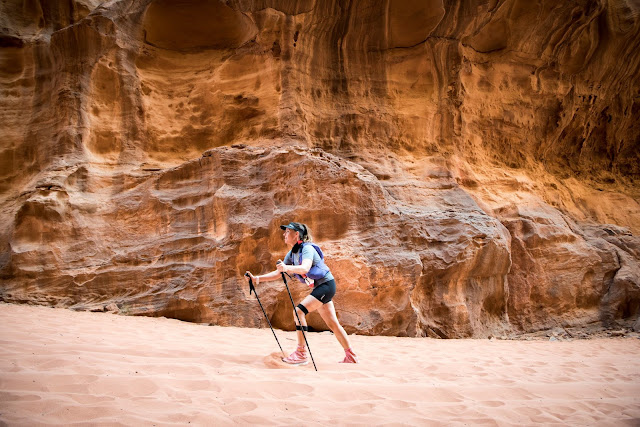
The Wadi Rum desert also has surfaces of hard sand, which is much easier to run on (similar to road running). What I hadn’t expected to see was areas of gravel-like surfaces and I never imagined I would see dry river beds. I learnt during my time there that in autumn there can be a lot of rain, filling up these river beds. Apparently in the spring time, all the flowers that seemed dead come up again, filling the desert with colour. The dry river beds were absolutely stunning. The colours and the crisp sound as you ran over them.
Each day, the courses were marked out with pink flags and checkpoints were positioned every 10km, besides day four and five where additional drink stations were put up in the last half of the courses.
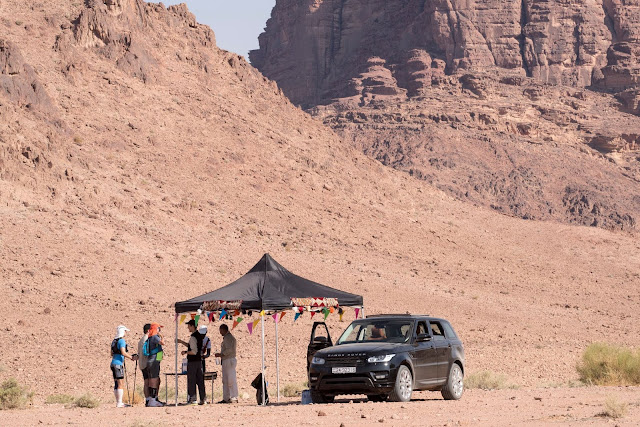
With hydration, I never struggled with muscle cramping and point this towards taking a salt tablet every 10 km. Electrolytes played a huge part in my drinking strategy; I carried two 750ml bottles with me. At each checkpoint, I would fill them both up with water and electrolytes.
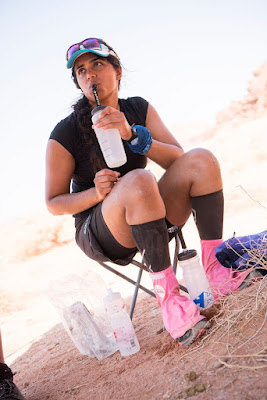
During the long day, I took an additional water pouch. I’m quite glad I brought that one along as I nearly suffered from dehydration when I was close to checkpoint five (50km in) – temperatures soared to nearly 40 degrees that day and there were large stretches of land where we were very exposed to the sun and heat. I would also take electrolytes designed for before and after the runs each day.
Nutrition was an interesting experience. Besides one item, everything I had packed with me was food I had tried and tested throughout my training. My on- course nutrition ranged from savoury food like mixed nuts and Pip & Nut almond butter sachets to sweet food like Soreen, Bounce balls, Clif bloks, OnePro Nutrition gels and Maurten. I had anticipated eating lots during the runs every day but this was far from what happened. Perhaps it was the heat, but on day one I found that I wasn’t hungry and struggled to eat as a result.
Throughout day one’s 45 km run, I ate only one Bounce ball and less than half a pack of Soreen – barely touching the rest of the food I had planned and packed. Whilst many of these items had worked for me back in UK, I just didn’t feel hungry in Jordan. My next strategy was to switch to the products I knew were working for me in the heat and take in 100 calories every hour: Soreen in small doses, OnePro Nutrition gels, Maurten, Cliff bloks and nut butter sachets. I had bought packs of babybel on a whim before the event and had never tried them during training. In fact, I hadn’t even eaten babybel since I was in primary school. Surprisingly, this had been something that worked really well for me during the ultra. Taking something new was quite risky but it worked for me. Don’t think I would recommend doing that though!
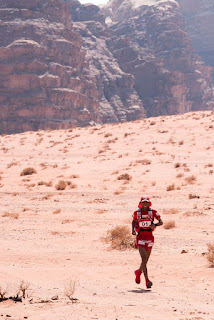
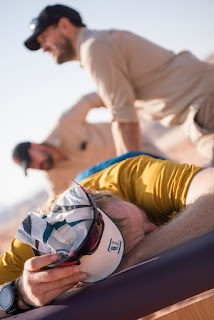
While Salameh would run with an empty-looking running vest, he’d have two small water bottles (less than 500 ml each). I saw him at one checkpoint and he hadn’t finished the drinks. Someone who was clearly so well accustomed to running in the heat.
I, on the other hand, would go through 1.5 litres every 10km – meaning on the long day I was drinking at least 10.5 litres of fluids – crazy! How I never needed to wee during the runs is beyond me.
The volunteers, who crewed us, played a huge role in helping us reach the finish line. There was about 15 volunteers, including two UK doctors, one local doctor and two osteos. At most of the checkpoints, there’d be a doctor and osteo so if there were anything we needed (blisters taping up/ quick sports massages etc) they would help. Wadi Rum Ultra 2018: An unforgettable experience that I am so glad I took part in. I learnt so much from the experience. People asked me if it was the hardest thing I’ve ever done, but surprisingly I’d say no. Your body adapts to the distance over the week and gets used to the heat. Ironman was in many ways tougher because it was one long, intense event within a day, using different sets of muscle groups. The Ultra London Duathlon in many ways felt harder than the Wadi Rum Ultramarathon. With the multi-stage Wadi Rum Ultra, each day the running was over by midday to early afternoon so you spent the rest of the day recovering. The Ultra London Duathlon involved running 20km, cycling 70km then running 10km. That felt so much harder. Your legs are constantly working and there’s no time to recover – plus the leg muscles used in cycling are different in running and cycling so adjusting to the feeling at each transition is something else.
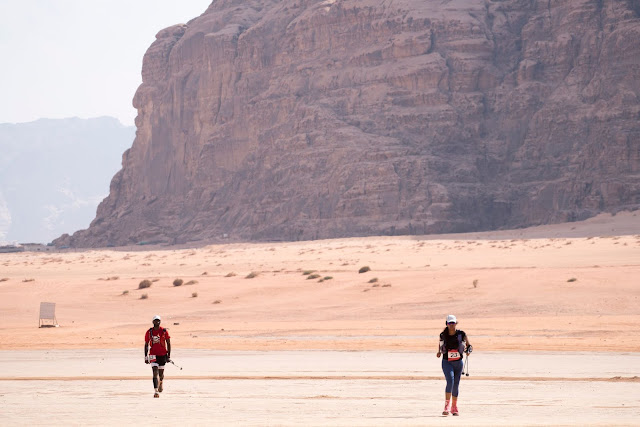
We were also asked at each checkpoint by a crew member how we were doing and how we felt. After running in open stretches of land with the heat, the checkpoints were often a welcome sight. The thing is though, as soon as you saw them from a distance, it was difficult to determine how far they were in the desert – it’s really difficult to determine distances in such a vast area.

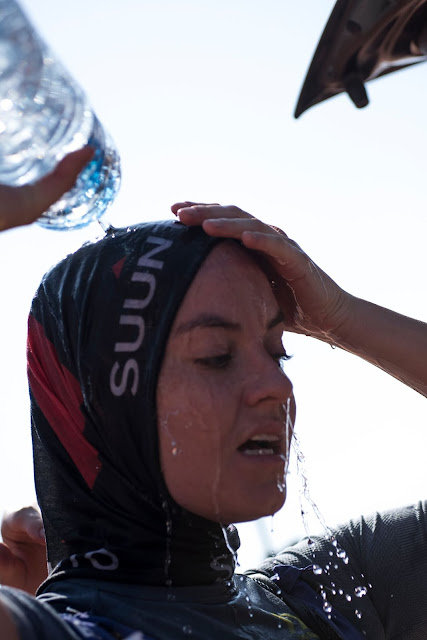
But as soon as we’d arrive at a checkpoint, there was relief. They were the points during the runs each day when we would be able to sit down under some shade. The crew would pour water over us to cool us down and remind us to take on electrolytes and salts, so there was no way we’d ever forget.
At the end of each day, we’d hobble/waddle over to the the osteos and doctors for sports massages, blisters being popped and taped over and other medical/physiology issues. I suffered problems with my achilles heel (injury that appeared just after Ironman UK), resulting in my calf and foot being taped up throughout the ultra. If it weren’t for the osteos, I don’t know if I would have been able to complete the ultra.
Besides the sand, the heat was a challenge to contend with during the ultra. By the end of day five, even if I was starting to get a bored of eating dehydrated food and drinking electrolytes, I will say that the electrolytes helped a lot in preventing muscle cramping and heat exhaustion and I’m glad I stuck with them. I sweat a lot and in the heat, I could feel the salt dry up on my face and see the salt crust over my top. By the end of day two, you got used to everyone’s sweat. Luckily, the camp we stayed at on day one and day two had basic showers and a bathroom, so we were able to give ourselves quick showers. Day four and day five, were slightly more luxurious, as we stayed in a tourist camp which had better showers. Honestly, washing off the salt and sweat on both those days were tiny pleasures along with the stretching sessions we did with the sunset in the background.

Day three was a special day during the ultra. It was the longest day, meaning we woke up at 3am for a 4am race start. Head lamps on, and glowsticks on our bags to guide us through til sunrise. Not forgetting to turn on our Garmins and Suuntos.

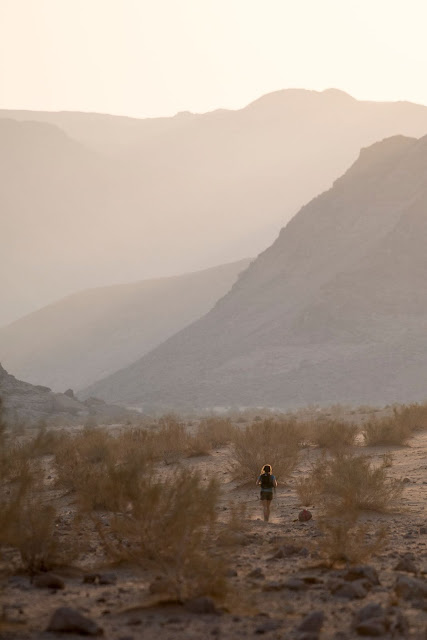

We were running 70 km from the camp to another site – this time we were going to sleep under the stars on a rock that resembled the one in The Lion King. Besides being the longest day, the day was made tougher by the cut-off times that were strictly implemented: every 10km had to be completed within two hours otherwise you would be picked up and taken off the course by one of the Range Rovers roaming up and down the course.

That sounds easy to do, but given the fatigue and stress our bodies were under along with the heat and the undulated sandy terrain, this was not an easy feat to do. Several people were picked up as a result. But once we arrived at the rock, the views were magnificent. We spent the night sleeping under the stars.
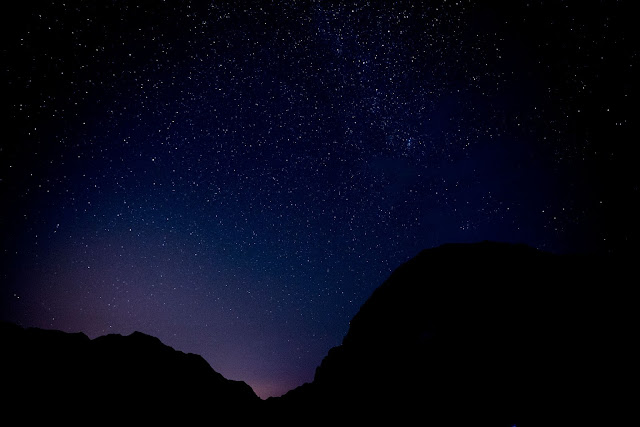
By Thursday, I think our bodies were adapting to the environment and the distances we were running. Another early morning race start and this time we were running from the rock to the tourist camp. My calf was taped up in a different way, relieving me of the pain from my achilles heel.

The run was absolutely incredible. I loved how every day, the routes took us through different types of terrain throughout the desert; no day was the same.

Funnily enough, Thursday was the day I ran my fastest and felt my strongest. The camp we stayed at for the last two nights was also used by tourists – the small huts in the camp housed two people each and had beds. No more sleeping bags!

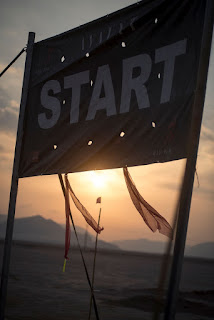
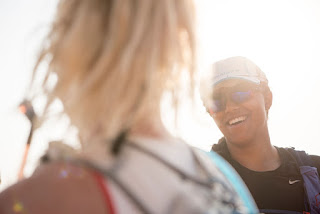
By Friday, we were starting to feel a bit stunned that the experience was nearly over. Yes, we were there running in the desert for five days, but those five days were intense and we had all got to know each other. Friday was meant to be a short 30 km or so ‘park run.’ Due to a mix up in
permits by the Wadi Rum officials, a Bollywood film company had also been given permit to use parts of the desert we were going to run through so a last-minute course change took place mid run, resulting in 7 km being added to the distance as we were re-directed. That felt brutal. Yet at the same time, the moment we crossed the finish line, it felt invigorating to say we had actually run longer than anticipated. I don’t know where it came from, but the last few metres of my finish saw me sprinting to the finish line. A sudden surge of speed appeared out of nowhere.

The kit that worked well for me are:
Saloman running vest – gifted to me by the brand. The bag had lots of compartments, fit lots of items and also held two 750ml bottles.
Precision Hydration – Salt tablets and electrolytes (I purchased).
Mountain King Trail Blaze Poles (I purchased).
OnePro Nutrition gels – gifted to me by the brand.
Maurten – carbohydrates-based drink (I purchased).
2XU Compression – calf guards and compression leggings (I purchased).
Brooks Cascadias running shoes ( I purchased – they were also one of the very few brands who had a women’s size 10 in stock. Apparently at the time purchased, they were the last one in stock throughout the whole of western Europe).
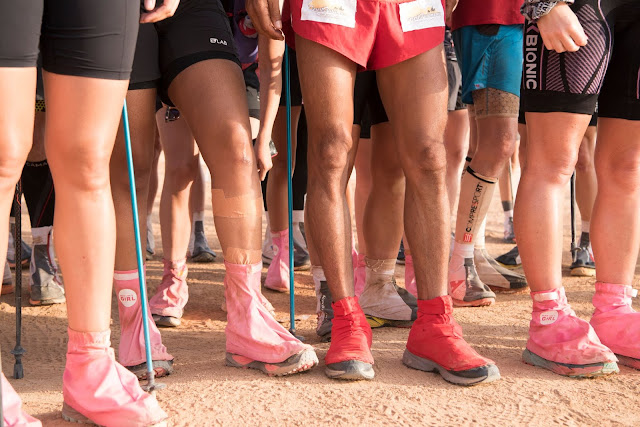
You can register for Wadi Rum ultra or other ultras across the world, organised by Ultra -X, here.
When I finished Ironman UK, I had wondered how I would top that off. Now after completing the Wadi Rum ultra marathon 2018, I wonder how I can top that experience off.
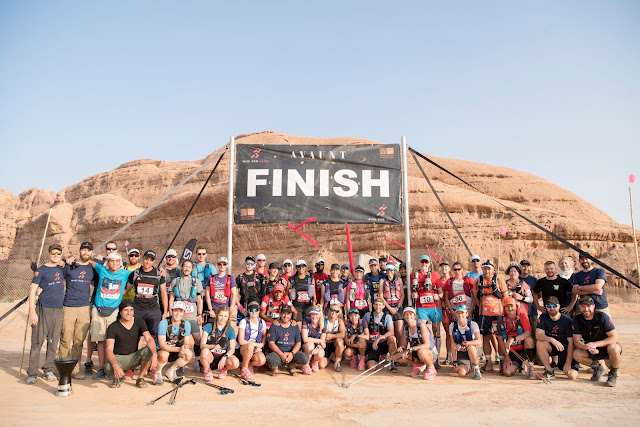

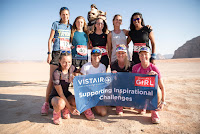
I took part in the Wadi Rum Ultra as part of Team Like a Girl (TLAG). Certain items were gifted to me through TLAG, including race entry. TLAG were sponsored by Codestone,Vistair, Saloman,Suunto and Tribe.
All photos by Benedict Tufnell, unless stated otherwise.